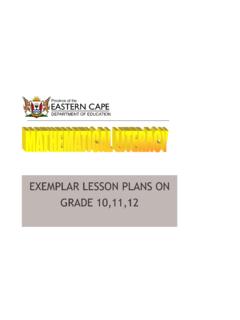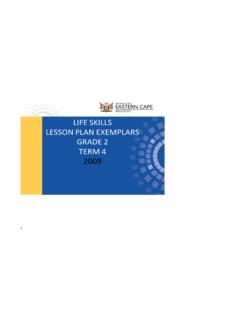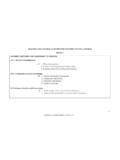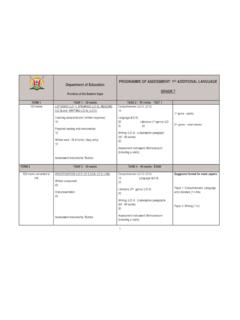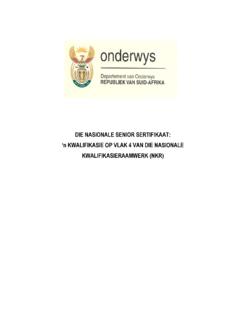Transcription of NATURAL SCIENCES LESSON EXEMPLARS SENIOR …
1 NATURAL SCIENCES LESSON EXEMPLARS . SENIOR PHASE. GRADES 7-9. 4TH TERM. AUGUST 2009. OVERVIEW. grade 7. TERM 1 TERM 2 TERM 3 TERM 4. LEARNING OUTCOMES LEARNING OUTCOMES AND LEARNING OUTCOMES AND LEARNING OUTCOMES AND. AND ASSESSMENT ASSESSMENT STANDARDS ASSESSMENT STANDARDS ASSESSMENT STANDARDS. STANDARDS LO 1. Scientific LO 1. Scientific Investigations: LO 1. Scientific LO 1. Scientific Investigations: Investigations: Investigations: AS 1. Plans Investigation AS 1. Plans Investigation AS 1. Plans Investigation AS 1. Plans 2. Conducts investigation and 2. Conducts investigation and Investigation collects data collects data 2.
2 Conducts investigation and collects data 2. Conducts investigation 3. Evaluates data and 3. Evaluates data and communicate and collects data communicate findings findings 3. Evaluates data and 3. Evaluates data and communicate findings communicate findings LO 2. Constructing Science LO 2. Constructing Science knowledge: knowledge: LO 2. Constructing Science LO 2. Constructing knowledge: Science knowledge: AS 1. Recalls meaningful AS 1. Recalls meaningful information information AS 1. Recalls meaningful AS 1. Recalls information meaningful information 2. Categorises information 2. Categorises information 2.
3 Categorises information 2. Categorises information 3. Interprets information 3. Interprets information 3. Interprets information 3. Interprets information 4. Applies knowledge 4. Applies knowledge 4. Applies knowledge 4. Applies knowledge LO 3. Science, Society and LO 3. Science, Society and Environment: Environment: LO 3. Science, Society and LO 3. Science, Society Environment: and Environment: AS 1. Understands science as AS 1. Understands science as a a human endeavour human endeavour AS 1. Understands science AS 1. Understands as a human endeavour science as a human 2. Understands sustainable use 2.
4 Understands sustainable use of endeavour of the earth's resources the earth's resources 2. Understands sustainable use of the earth's resources 2. Understands sustainable use of the earth's resources Life and living Life and living Life and living Life and living Different food types- Interaction in the environment- Cell-animal and plant cell - structure Circulatory system-structure proteins, fats, ecosystems-food chain ,food and functions and functions. carbohydrates, minerals, web Life processes-breathing system, Reproduction in plants- vitamins, water. Classification of animals- excretion-elimination of waste, pollination fertilization, fruits Absorption of food vertebrates and invertebrates- Importance of water-kidney, skin, and seeds Requirements for different classes, stomata Matter and materials photosynthesis Characteristics Matter and materials Magnetism-magnetic fields, Storage organs in plants- Matter and materials Origin of raw materials.
5 Polarity roots, stem, leaves Acids and bases, indicators Radiation-dark coloured and light Energy and change Matter and materials Household acids and bases, coloured substances Heat transfer-conduction, Different types of salts and neutral solutions Conductors, Resistors convection, radiation solutions Reactions and changes of Pure substances and mixtures Solubility-solvent, solute. materials-acids and bases- Methods of separation of mixtures- Earth and beyond Phases of matter- characteristics, physical separation-filtration, Mining- properties-physical Household acids & bases distillation, evaporation, Advantages and changes-melting, Indicators chromatography disadvantages evaporation, Neutralization Energy and change Safety and environmental condensation, Products of neutralization Wood as a source of energy and its impacts.
6 Solidification, diffusion, Energy and change renewability and heating by conduction Fossils, fossil fuels Earth and beyond crystalline structure/ Renewable (wind, sun and Mining-in different provinces compressibility/ non- water) and non renewable Significance of mining to man compressibility (fuels, coal, gas and oil) sources Energy and change of energy. Energy transfer and systems Types of energy- Energy and change potential energy, kinetic Atmosphere layers of the energy atmosphere Uses of energy, examples Atmospheric gases of energy transfer and Properties of atmosphere at systems-electrical, different elevations to protect gravitational, mechanical, earth from harmful radiations.
7 Chemical, nuclear, solar, biomass, optical (light). Earth and beyond Solar system Celestial motion Phases of moon Eclipses Tides and phases of moon and eclipses. grade : 7 Learning Area: NATURAL SCIENCES Strand: Life and Living Duration: Weeks 1-2 Content in context: Circulatory System - Structures and Function Integration: Language: LO 5 Mathematics: LO 4 & 5. Los and Ass Teaching & Learning Activities Details of assessment LO 1: SCIENTIFIC Activity 1 Assessment Task INVESTIGATIONS Learners discuss in groups how they think blood is transported in human Research Project body and identifies the different parts of the blood circulatory system and Learners visit nearby Health AS: Plans investigations: the function of the heart.
8 Centres to do a research on the AS: Conducts investigation Teacher asks learners to listen to the next persons heart beat, count for a minute and takes the average value of responses from different risk factors of Cholesterol, and collects data learners. High Blood Pressure, AS: Evaluates data and The teacher uses an analogy (Transport system: taxis, buses, etc.) to Hypertension, Asthma, and communicates findings explain the circulatory systems in human beings. other Heart related diseases. LO2: CONSTRUCTING Teacher explains the composition and function of blood. Write a written report based on SCIENCE KNOWLEDGE: the information collected under Activity 2: AS: Recalls meaningful the heading risk factors, With the help of charts/ models the teacher explains different parts of the information:: circulatory system which are heart and blood vessels.
9 Causes, preventive measures. L O 3: SCIENCE, SOCIETY Learners identify the parts of the circulatory system. Make a drawing of the circulatory system. AND THE ENVIRONMENT. Teacher engages the learners in the discussion of the structure and AS: Understands science and functions of the heart and different blood vessels. Make a model of the heart. technology in the context of history and indigenous Activity 3: The learners do research on the risk factors of heart related knowledge. diseases and have to present it to the class. Activity 4: Discuss health risks and heart diseases and the relationship to have a healthy diet.
10 [The special arteries that bring blood and oxygen to the heart muscle can clog up. They can clog up with clumps of fat called plaque. Blood cannot flow through clogged arteries. Clogged arteries can cause heart attacks. Exercise is one way to keep your heart healthy. Eating fruits, vegetables, and low-fat meats is another way to keep your heart healthy. You should have regular physical checkups. The main way to keep your heart healthy, however, is not to smoke. Heart Related Diseases are normally found from people who sometimes fail to take precautionary measures and they can prove to be fatal at times].
